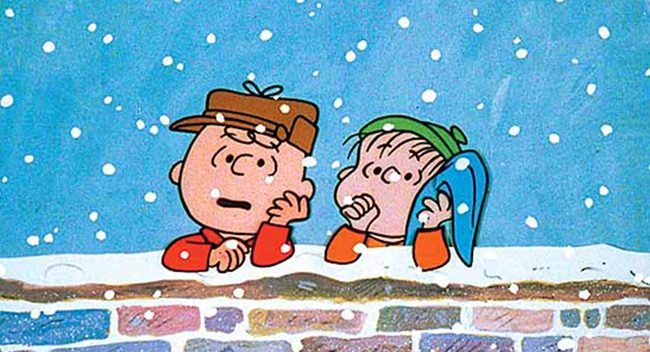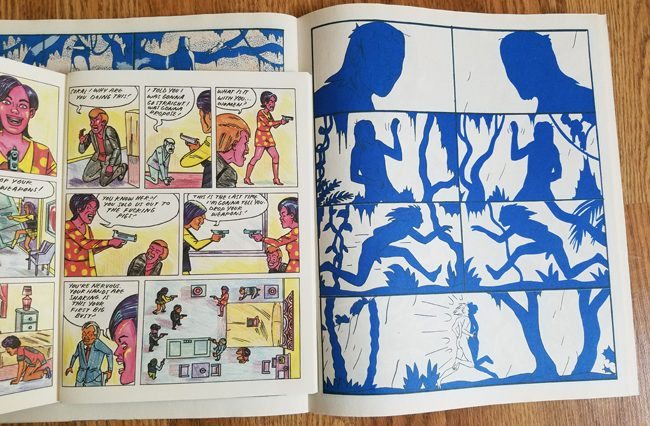 The animated movie I wrote and directed, My Entire High School Sinking into the Sea, opens this weekend in New York, Los Angeles, and Toronto. The Metrograph theater in New York let me decorate their walls with original artwork from the film, and I also curated their small upstairs bookstore, which carries rare DVDs, film-related books, and issues of Cahiers du Cinéma. They asked me to pick books and DVDs that felt related to my movie, or that a cinema-going audience would be interested in. Here are some of the things I selected, and why.
The animated movie I wrote and directed, My Entire High School Sinking into the Sea, opens this weekend in New York, Los Angeles, and Toronto. The Metrograph theater in New York let me decorate their walls with original artwork from the film, and I also curated their small upstairs bookstore, which carries rare DVDs, film-related books, and issues of Cahiers du Cinéma. They asked me to pick books and DVDs that felt related to my movie, or that a cinema-going audience would be interested in. Here are some of the things I selected, and why.
The Adventures of Prince Achmed is a German animated film by Lotte Reiniger done in cut-out silhouettes against color fields. Made in 1926, it's likely the first feature-length animated film. Although it's well known, I'm always surprised how few people have actually seen it. Reiniger's silhouette work was a key inspiration for Kara Walker. This movie is the perfect embodiment of "independent cinema"—the means/budget is tied to the aesthetic. It's more powerful because it's minimal. This is truly an "auteur" movie, much more so than the larger-scale collaborative films of the French New Wave that defined the term. The silhouette sequence in High School Sinking is an homage to this movie.
Another perfect example of limited animation, and more specifically limited animation derived from comics, is A Charlie Brown Christmas. So much has been written about this canonized Christmas special and its unusual holiday message. Something I haven't heard discussed about these Peanuts television specials is their odd, idle pace. Some of the lesser-known Peanuts specials, like the Thanksgiving one, have an episodic pace that's based on a series of the comic strips strung together. By adhering so closely to the original comic strips, they arrive at something unusual in cinema. Also, unlike almost every kids' cartoon, the voice acting is relatively naturalistic. These kid characters, who act neither like children nor adults, don't have the over-the-top high-pitched voice acting you hear in contemporary cartoons. (Many of the side characters were voiced by non-actors.) Their dry delivery coupled with the slow pacing magically equals something that is unusual, gentle, and somehow outside of time.
Another DVD I had to include was Henri-Georges Clouzot's Mystery of Picasso, because I'd never seen this film placed under the umbrella of "animation." This is a filmed record of Picasso painting live. Picasso knows he's being watched, so he chooses his strokes and arrangements to make dramatic reveals and changes to the "story" as it's being unveiled. This is dramatic drawing, and Picasso has perfect comic timing! There are lots of goofy jokes in this movie, as marks come together in unexpected ways. Most of the paintings were destroyed after the movie, another sign that their sole purpose was to been seen as they were brought to life, animated.
https://www.youtube.com/watch?v=FSoJUMnLc1o
For obvious reasons, The Drifting Classroom is often brought up in relation to High School Sinking, although I don't remember thinking that much about it. Drifting Classroom is about a school that drifts through a portal into another dimension where it's attacked by monsters. The first High School Sinking comic (which appeared in Mome) was clearly inspired by Titanic, but a surprising number of manga are about schools in danger. For example, almost every episode of Sailor Moon has a monster attacking a school. Even many of the adult cartoons, like Urotsukidoji, are about creatures, usually demons, attacking schools. The study period prior to college in Japan translates to "Study Hell." All of these monsters must be a literalization or dramatization of the pain and turmoil of that age. It's hard to think of a comic comparable to Drifting Classroom in terms of visceral power and masterful cartooning. It's relentless. It's a comic that's best when you're inside of it, before it's over and after it's begun, racing through its panels. My favorite school-in-danger anime is the 1970's cartoon based on the Devil Man comic series created by Go Nagai. These cartoons, like the Bakshi Spider-Man cartoons, are so brutal and demented that it's scary to imagine them being aired on television and innocent children subjected to them. The Devil Man series recently came out as a box set that includes all of the episodes.
https://www.youtube.com/watch?v=W1y-ZgP_xqE
Also active in 1970s Japan was King Terry, who created the 30-minute limited-animation curiosity 100 Channels. King Terry is the godfather of the "heta-uma" illustration movement, which translates as "unskilled use of skill." Terry subverted many of the conventions of illustrations. Instead of drawing larger and reducing drawings in print so that they'd be tighter and more detailed, he'd draw small and then blow them up, resulting in bold, thick-line drawings, maybe inspired by the thick lines seen in Roy Lichtenstein paintings, which are often referenced in Terry's work. Terry wrote playful manifestos about "heta-uma" that declared "draw however you like," but there was obviously an anti-establishment (or at least contrarian) sensibility to his work. It asked, "Why would you judge a drawing? What do we consider beautiful? Why?" etc. Sadly, the "heta-uma" movement was appropriated by people who just weren't very skilled at drawing to begin with. But we have this gem of animation, funky music behind cut-out figures by Terry. This was reissued by PictureBox not too long ago, so it is easier to find than the limited animations of Seiichi Hayashi, which you have to buy an expensive box set to see.
The closest link to 100 Channels, in my mind, is Pee-wee's Playhouse, so I included the box set of Season 1 and 2 at the Metrograph bookstore. When I watched episodes of this again recently, what stood out to me is their manic pace. Playhouse predicted YouTube and short-attention-span internet blips. I tried to think of it as a possible precursor to all of the "quirky" and "twee" characters we see in contemporary television and cartoons, or the man-children of Judd Apatow comedies, but the Pee-wee characters are more severe. Imagine placing artwork from Pee-wee into a Cartoon Network show, or having Pee-wee walk into a Sundance comedy-- they would be out of place. Pee-wee's Playhouse is much more abrasive in its pace and characterization. If it was done today, I believe it would be softer in some way.
I wrote a piece for the Metrograph program book about watching cartoons on psilocybin mushrooms, describing the effects of the opening title sequence of Speed Racer, so I wanted to include in the bookstore Incanto by Frank Santoro, who also painted the key exterior background paintings in High School Sinking. This particular zine by Santoro is lovely and poetic, and also, to me, utterly hilarious, because a section of it comes from a Speed Racer episode. Santoro told me that this was drawn after working as Francesco Clemente's assistant. Clemente would often interpret preexisting old drawings, so that inspired Santoro to adapt a two-second Speed Racer moment. It's perfect-- like seeing something you've seen before for the first time. He captures the stillness of those Speed Racer cartoons with their minimal background paintings.
Like comics, limited animation says, "Look at what you can do with so little." Like magic lanterns from the 1700s, which used still images in a very similar way to Speed Racer and limited animation, a whole universe is created with only still images sliding across a screen.
I also wanted to pick a couple of newer comics that you could hand to a stranger and they would enjoy without any explanation. Lovers in the Garden by Anya Davidson and Mowgli's Mirror by Olivier Schrauwen are two books from Retrofit Comics that are perfect to display to a non-comics-reading audience. For one thing, they have a low price point. This printing of Mowgli's Mirror is the best version of it in the world. Also, both books have strong stories and crystal clear cartooning coupled with unusual aesthetics. And they're perfect for Metrograph because Lovers in the Garden recalls '70s crime movies and Mowgli's Mirror echoes silent film, puppet theater, and even, in one sequence, Lotte Reiniger.










